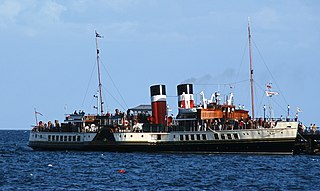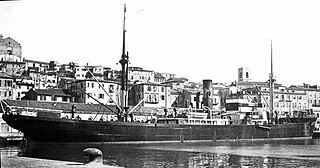
Robert Miles Sloman (23 October 1783, Great Yarmouth - 2 January 1867, Hamburg) was an English-German shipbuilder and ship owner.

Robert Miles Sloman (23 October 1783, Great Yarmouth - 2 January 1867, Hamburg) was an English-German shipbuilder and ship owner.
Robert Miles Sloman was the son of William Sloman, an English ship's captain who in 1785 settled in Hamburg with his wife and two sons William Palgrave Sloman and Robert Miles Sloman. William Sloman became a Hamburg citizen in 1791 and established his first company in 1798 as a ship broker. On his death in 1800 Robert Miles Sloman, then 17 years old inherited the ship broker business and a few sailing ships. After the Treaty of Amiens (25 March 1802) Robert Miles went to Antwerp to found a shipbroking-company but as war broke out again he had to return to Hamburg. Napoleon I then blocked the harbour of Hamburg as part of the Continental System so Sloman moved his business to Tönning at the mouth of the river Eider, then a part of Denmark. In 1806 he married Gundalena Brarens, the daughter of pilot inspector and nautical examiner Hinrich Brarens from Tönning. [1]
Denmark eventually joined the Continental System but the company survived. In 1814 Sloman reopened his shipping business, at first in Cuxhaven English Consul. When French troops gave up Hamburg, Sloman returned but his last ship sailing under English colours was confiscated by the French and it was not insured properly. Under Hamburg laws as a broker Sloman was forbidden to act as a ship owner so his captains, who part-owned the ships founded ghost-shipping-companies.
The shipping company Rob. M. Sloman & CO. oHG took passengers to and from England but on 17 February 1836 the shipping company opened the first regular transatlantic service from Hamburg to New York with the bark Franklin and two other sailing packets. On 8 May 1841 Sloman and eight other shipowners formed Hanseatische Dampfschiffahrts-Compagnie and built in England two paddle steamers, the Hamburg and the Manchester which sailed to and from Kingston upon Hull and by 1846 the transatlantic fleet had grown to seven. The Sloman Line had a competitor in the Hamburg- Amerikanische Packetfahrt Aktien-Gesellschaft which was formed in May 1847. When their first sailing packet, Deutschland, left Hamburg on her maiden voyage in October 1848, Sloman responded in 1850 by changing from sail to steam with the British-built, iron-hulled screw steamship, Helena Sloman. This ship was lost on only her third transatlantic voyage. Another iron screw ship was ordered by Sloman in 1853, but then Hamburg- America decided to switch from sail to steam. Sloman immediately offered to run a joint service with his rival's steamships, but they rejected his proposal. Hamburg-America's transatlantic steamship service began on 1 June 1856, when the Borussia set off for New York with sister-ship Hammonia following a month later. Sloman gave up on steamships and remained a sailing packet line. In 1898 R Slowman Company bought the 3739 ton steamer Moravia from the American Hamburg Line and renamed it the Parma.
Robert Sloman with business associates Johann Cesar VI. Godeffroy, Johann Christian Jauch, Ernst Merck and Johann Heinrich Schröder organised the Internationale Landwirtschaftsaustellung (International Agricultural Exhibition) at Heiligengeistfeld in 1863 [2] and was a member of its guarantee fund. [3] In 1865 he was a joint founder of the German Maritime Search and Rescue Service.
Sloman was a member of the Hamburg Parliament from 1859 to 1861. [4]

The Cunard Line is a British shipping and cruise line based at Carnival House at Southampton, England, operated by Carnival UK and owned by Carnival Corporation & plc. Since 2011, Cunard and its four ships have been registered in Hamilton, Bermuda.

Albert Ballin was a German shipping magnate. He was the general director of the Hamburg-Amerikanische Packetfahrt-Actien-Gesellschaft (HAPAG) or Hamburg-America Line, which for a time was the world's largest shipping company. Being the inventor of the concept of the cruise ship, he is known as the father of modern cruise ship travel. Albert Ballin was a risk-taker who was willing to challenge his colleagues, foreign competitors, and domestic politics in order to build a successful shipping company. He focused on British rivals and was determined to expand HAPAG's global reach, he also worked closely with the Kaiser and supported expansion of the German navy.

A steamship, often referred to as a steamer, is a type of steam-powered vessel, typically ocean-faring and seaworthy, that is propelled by one or more steam engines that typically move (turn) propellers or paddlewheels. The first steamships came into practical usage during the early 1800s; however, there were exceptions that came before. Steamships usually use the prefix designations of "PS" for paddle steamer or "SS" for screw steamer. As paddle steamers became less common, "SS" is incorrectly assumed by many to stand for "steamship". Ships powered by internal combustion engines use a prefix such as "MV" for motor vessel, so it is not correct to use "SS" for most modern vessels.

The Blue Riband is an unofficial accolade given to the passenger liner crossing the Atlantic Ocean in regular service with the record highest average speed. The term was borrowed from horse racing and was not widely used until after 1910. The record is based on average speed rather than passage time because ships follow different routes. Also, eastbound and westbound speed records are reckoned separately, as the more difficult westbound record voyage, against the Gulf Stream and the prevailing weather systems, typically results in lower average speeds.

Charles Morgan was an American railroad and shipping magnate. He played a leading role in the development of transportation and commerce in the Southern United States through the mid- to late-19th century.
Norddeutscher Lloyd was a German shipping company. It was founded by Hermann Henrich Meier and Eduard Crüsemann in Bremen on 20 February 1857. It developed into one of the most important German shipping companies of the late 19th and early 20th centuries, and was instrumental in the economic development of Bremen and Bremerhaven. On 1 September 1970, the company merged with Hamburg America Line (HAPAG) to form Hapag-Lloyd AG.

USS Santiago de Cuba was a side-wheel steamship acquired by the Union Navy during the first year of the American Civil War. She was outfitted as a gunboat with powerful 20-pounder rifled guns and 32-pounder cannon and was assigned to the Union blockade of the Confederate States of America. She was notably successful in this role, capturing several blockade runners. Her last major action of the war was the assault on Fort Fisher, during which seven of her crew won the Medal of Honor.

The Pacific Mail Steamship Company was founded April 18, 1848, as a joint stock company under the laws of the State of New York by a group of New York City merchants. Incorporators included William H. Aspinwall, Edwin Bartlett, Henry Chauncey, Mr. Alsop, G.G. Howland and S.S. Howland.

The Inman Line was one of the three largest 19th-century British passenger shipping companies on the North Atlantic, along with the White Star Line and Cunard Line. Founded in 1850, it was absorbed in 1893 into American Line. The firm's formal name for much of its history was the Liverpool, Philadelphia and New York Steamship Company, but it was also variously known as the Liverpool and Philadelphia Steamship Company, as Inman Steamship Company, Limited, and, in the last few years before absorption, as the Inman and International Steamship Company.
The Collins Line was the common name for the American shipping company started by Israel Collins and then built up by his son Edward Knight Collins, formally called the New York and Liverpool United States Mail Steamship Company. Under Edward Collins' guidance, the company grew to be a serious competitor on the transatlantic routes to the British Cunard shipping company.
De Hamborger Veermaster is a famous sea shanty sung in Low German, presumably first published between 1850 and 1890. It is partly in English, an adaptation of the shanty "The Banks of the Sacramento", and partly in Low German. Particularly in Northern Germany, it was and still is sung as a work song.

SS Georgia was a passenger and cargo ship that was launched in Germany in 1891 as Pickhuben. The Hamburg America Line acquired her in 1892, and renamed her Georgia in 1895. In 1915 a US company bought her and renamed her Housatonic.

Packet boats were medium-sized boats designed for domestic mail, passenger, and freight transportation in European countries and in North American rivers and canals, some of them steam driven. They were used extensively during the 18th and 19th centuries and featured regularly scheduled service. Steam driven packets were used extensively in the United States in the 19th century on the Mississippi and Missouri rivers, supplying and bringing personnel to forts and trading posts.
The Liverpool and Great Western Steamship Company, known commonly as the Guion Line, was a British passenger service that operated the Liverpool-Queenstown-New York route from 1866 to 1894. While incorporated in Great Britain, 52% of the company's capital was from the American firm, Williams and Guion of New York. Known primarily for transporting immigrants, in 1879 the line started commissioning Blue Riband record breakers to compete against Cunard, White Star and Inman for first class passengers. The financial troubles of one of the company's major partners in 1884 forced the firm to return its latest record breaker, the Oregon, to her builders and focus again on the immigrant trade. The company suspended sailings in 1894 because of new American restrictions on immigrant traffic.

SS Baltic was a wooden-hulled sidewheel steamer built in 1850 for transatlantic service with the American Collins Line. Designed to outclass their chief rivals from the British-owned Cunard Line, Baltic and her three sister ships—Atlantic, Pacific and Arctic—were the largest, fastest and most luxurious transatlantic steamships of their day.

SS Pisa was a cargo and passenger steamship that was built in Scotland in 1896. She was in German ownership until 1917, when the United States seized her and renamed her Ascutney.

SS Archimedes was a steamship built in Britain in 1839. She was the world's first steamship to be driven successfully by a screw propeller.
Teutonia was a screw steamer that was built by Caird & Company, Greenock, Renfrewshire, Scotland for the Hamburg Brazilianische Packetschiffahrt Gesellschaft in 1856. It later served with the Hamburg Amerika Line before being sold to British owners in 1877 and Italian owners in 1884, serving them under the names Regina, Piemontese, Città di Savona and Mentana The ship was scrapped in 1894.
HMS Argus was a steamship that was built in Scotland in 1904 as a cutter and fishery protection ship for the His Majesty's Coast Guard, and later served in the Royal Navy as HMS Argon. After the First World War she was converted into a passenger ferry, serving first the Isles of Scilly as Peninnis and then in the Channel Islands as Riduna. She was scrapped in England in 1932.
Hinrich Braren, later known as Hinrich Brarens, was a Danish sea captain, pilot inspector and nautical examiner. He wrote the first book on navigation in German language and established the first public nautical school in the Duchy of Schleswig. Within 30 years as a nautical teacher he examined about 3,500 navigator candidates.
{{cite news}}: Missing or empty |title= (help)